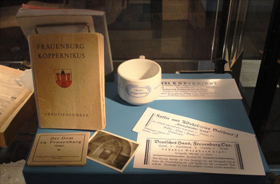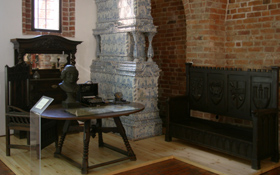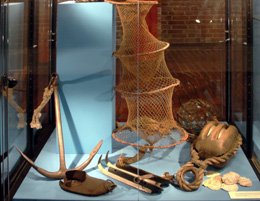|
|
|
|
|
700 years of the city of Frombork exhibition. Exhibition is available from the 8th of July 2010 in the main museum building (a former bishop's palace) on the Cathedral Hill in Frombork. It was prepared in connection with 700th anniversary of granting municipal rights to Frombork. Because human actions over time often go forgotten or distorted, therefore we consider it necessary and very useful to write in the presence of witnesses to perpetuate what is worth preserving. Therefore we, Eberhard, the bishop of Nyssa (...) we do open to all and sundry, now and in the future, with the advice and consent of the chapter, we give full rights to the city (...) on behalf of the Lübeck Laws. For all of this, with the consent of the chapter, decided for the benefit of our earth, has survived intact and has taken a lifetime of power, we made it written and sealed with the seal of our chapter, and notice of witnesses and many other worthy men of faith, whose names have not been presented. The attached quotation is a fragment of charter, written by Frombork Parson Peter, which refers to founding of Braniewo. Frombork tracking documents have not survived, but the content stored in those acts were similar, because only Frombork and Braniewo were founded on behalf of Lübeck Law. The name of the city, invested on the 8th of July, 1310, was received from the Virgin Mary, patroness of the cathedral. German settlers called it Frauenburg, and canons of Warmia, in its documents written about it Dominae Nostrae Castrum - Our Lady of the Castle. After the World War II, the city was named Frombork. From 1320 to 1772, the town remained under the authority of the chapter, and since 1772 - under the office of Prussia. Cathedral's fortress, surrounded by a ring of walls, functioned independently and up till 1926, the hill and the city were separate administrative units. In contrast to the Cathedral Hill, the city has never had masonry fortifications, but only the city gates: the so-called Mill Gate from the West, and the Manilow Gate from the East. Embankments and palisades were created in order to provide a sufficient level of security for the city. During the risks of war, people of Frombork found their shelter on the Cathedral Hill The exhibition includes several sections, which are related to the important stages of the development of the city. This applies both to objects produced here, various crafts development and economic life, but also the subsequent rebuilds of the devastation caused by wars over the centuries. An important item in the historical buildings of the city is the preserved water tower. In conjunction with the canal and aqueduct, was the outstanding achievement of hydro-engineering of the XVI century. On the northern side of the town, up to XVII century, a sailor tower had stood. It had been destroyed during the Swedish wars and was rebuild in the1980s. On the eastern suburb there was a St. John's leprosery and, preserved to this day, a hospital complex with St. Anne's chapel. Aqueduct and Copernicus's canal. The first mention of a 4976-meter-long channel, which started from the river Bauda, come from 1427. For centuries the canal served the residents as a source of energy and drinkable water. Currently, the channel - known unofficially as the Copernicus channel - does not work. In 1571 a water tower was built over canal's bed. The tower housed the machine used for ladle lifting the water. The water was then distributed at the Cathedral Hill and the houses of the canons. Construction took a year and was only the second such kind of water supply in Europe. The first one was created in 1548 in Augsburg. Parish Church of St. Nicholas The population residing in Frombork had its parish church. St. Nicholas, built in the first half of the XIV century. The cathedral on the hill was reserved for major celebrations involving the bishop and for canons' service only. After the destruction in 1945, only perimeter walls survived and in the years 1972-1973, using the survived walls, the roof was built and placed. The whole building functioned as city boiler house until 2002. City life of the town - artefacts of the material culture. Archaeological studies conducted from 1958 to 1982 in the city, the Cathedral Hill and on the St. Spirit hospital complex, enabled the acquisition of valuable archaeological material in the form of pottery, porcelain and stoneware, which in the past served the residents to store food supplies, as well as tableware for everyday use. The archaeological work also discovered monuments that speak of the previously existing trades in the city: millers, shoemakers, tailors, blacksmiths and brewers. Development of different walks of life from the late nineteenth century Due to urban development since the mid-nineteenth century new investments began to appear in Frombork. Tourist traffic had slightly developed due to raising interest in history, but first and foremost a person of Nicolaus Copernicus, who lived and worked in the town for over 30 years. The need to provide full service for tourists was the cause for many hotels, youth hostels, as well as restaurants and shops being created. Hoteliers, who wanted to encourage tourists, advertised their services in newspapers and telephone books using the slogan :Visitors to the cathedral most pleasant welcome. Well-prepared rooms for visitors, moderate prices, known for wine, beer and tried cuisine. The exhibition also devoted much space to present the development of mail in the town. The collection of postcards exhibited speaks not only for the development and transformation of forms of correspondence, but also shows views of the town from the late XIX to mid XX century. Presentation of the city in the iconography: Development, history and views of the town from the last century can be seen not only on postcards, but also on the works of art in graphics, painting and drawing, all of which are presented at the show. Information about the wars and subsequent restorations of the town is shown in one of the many boards, and the last destruction of the city during World War II is further illustrated with photographs. The recovery time after the devastation of the city is illustrated with objects and documents occupying two showcases. In one of them various relics, collected and extracted from the debris of the houses, are presented. The relics were also acquired from the former inhabitants? homes. Another display case shows the history of the campaign, which lasted for couple years, under the name Operation 1001 Frombork, in which many thousands of scouts were involved. In order to enrich the exhibition, many of the relics originally presented in the exposition hall are also shown. These include a group of stained-glass windows from 1907, originating from the pre-war building in the county of Braniewo, which show various cityscapes of Warmia (Orneta, Frombork and Pieniê¿no), as well as the two Baroque stoves. Around one of them the interior was arranged. It consists of the furniture set, which could belong to the official premises of the XX century. Apart from furniture and decorative arts, the Copernicus's bust is presented on the table-desk, along with the daily newspapers (from the years 1923-1944) with articles devoted to Copernicus and the city and bills from businesses and artisans working in Frombork in the first half of the XX century. Presentation of events in the city. Not all events can be illustrated with monuments. The city's history is presented in the form of a timeline. History of town's visits by monarchs, heads of states and other leaders are further illustrated by the photographs. The history of the city coat of arms transformations, also illustrated, occupy a small space in one of the showcases.
|
|
|




